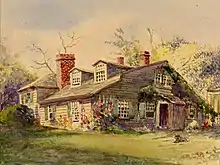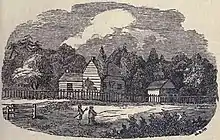James Givins
Colonel James Givins (sometimes James Givens) (circa 1759 – March 5, 1846) was a British Army officer and militiaman who fought in the American Revolution and the War of 1812. He was also a senior officer in the Indian Department of Upper Canada, serving as Chief Superintendent from 1830 to 1837. He is the namesake of Givins Street in Toronto.[1]
James Givins | |
|---|---|
| Chief Superintendent of Indian Affairs | |
| In office April 1, 1830 – June 12, 1837 | |
| Preceded by | Henry Charles Darling |
| Succeeded by | Samuel Jarvis |
| Personal details | |
| Born | c. 1759 Unknown location, possibly Ireland |
| Died | March 5, 1846 Toronto, Canada West |
| Spouse |
Angelica Andrews (m. 1797) |
| Children | Saltern Givins Caroline Ann Givins |
| Military service | |
| Allegiance | |
| Branch/service | |
| Rank | Colonel |
| Unit | Queen's Rangers York Militia Indian Department |
| Battles/wars | American Revolutionary War (POW) War of 1812 |
Early life

Givins place of birth is unknown, but it has been suggested he was born in Ireland. He may have been related to Henry Hamilton, as John Graves Simcoe referred to him as having been "bred up" by Hamilton. Givins came to Fort Detroit when Hamilton was posted there in 1775. Part of a British unit that seized Fort Vincennes, Indiana, in 1778, Givins was captured by American forces when they retook the post in 1779 and spent two years as a prisoner of war.[2]
Givins was released in 1781. No record exists of his activities until he was appointed a lieutenant with the Queen's Rangers on November 30, 1791.[3] Knowledgeable in Ojibwe, he served as a courier and interpreter for Lieutenant Governor Simcoe in Simcoe's dealings with the province's Indians. In June 1797 he was appointed the post of Indian Agent for the town of York by Peter Russell. Among Givins's duties were various official interactions with Indian bands, such as the distribution of annual gifts due from land surrenders. He was also charged with the task of keeping the Six Nations of Upper Canada under Joseph Brant's leadership from forming a viable alliance with the Mississaugas of Upper Canada.[2][3] He married Angelica Andrews on December 29, 1797.[4] In 1802 Givins built a large estate west of Toronto on land he received as a loyalist fighter in the American Revolution. He dubbed the estate Pine Grove.[1] The Queen's Rangers were disbanded in 1803, and Givins was made a captain of the 5th foot regiment on November 19, 1803.
War of 1812

Although Givins had retired from the military, he was recalled to active service at the outbreak of the War of 1812. He was given the rank of major in the York Militia and appointed Provincial Aide-de-Camp to General Isaac Brock. Givins fought in several battles, including the Battle of Detroit and on the Niagara Peninsula.[2]
In his role as an officer in the Indian Department, Givins helped coordinate a band of Mississauga warriors during the Battle of York on April 27, 1813. His performance there was favourably noted by Sir Roger Hale Sheaffe, when the men under his command were the first to engage the landing American troops. After coming under fire from the Americans, and their own relief failing to arrive, he and his men retreated to Pine Grove where his wife Angelica attended to their wounds. Blood from the wounded stained the floors, which remained stained until the house was demolished in 1891.[1][2][5][6]
Later life

Givins remained a militia member after the war's end, although his main focus was the Indian Department. He was promoted to Colonel of the 3rd Battalion of York Militia on January 21, 1820, and Colonel of the 1st Battalion of West York in 1821. After the war, the focus of the Indian Department changed, as military alliances with the Indians were no longer valuable. Instead, the Indian Department looked to convert the Indians to the British lifestyle. Givins was heavily involved with the Credit Mission, working with Mississauga leader Peter Jones to establish the settlement and pioneer it as an example Indian settlement. The success of the Credit Mission was noted in Henry Charles Darling's report on the state of the province's Indians, and the settlement became a model for the reserve system. Givins was given the job of Chief Superintendent of the Indian Department in Upper Canada in 1830. He retired in 1837, and was replaced by Samuel Jarvis.[2][3][7]
Givins died in 1846 at his estate Pine Grove in Toronto, and was buried in St. James Cemetery.[2]
References
- Adam Mayers (3 May 2007). "Blood-stained floor told the tale". Toronto Star.
- John F. Leslie (1966). Dictionary of Canadian Biography. University of Toronto Press. ISBN 0-8020-3398-9.
- "Colonel James Givins".
- "Weddeings at Niagara". Papers and Records. Toronto: Ontario Historical Society. 3: 7–73. 1901.
- Robert and Thomas Malcomson (October 1998). "War of 1812: Battle of York". Military History. Weider History Group.
- Peppiatt, Liam. "Chapter 1A: The Givins Homestead". Robertson's Landmarks of Toronto Revisited. Retrieved 3 July 2015.
- "Individuals Responsible for Indian and Northern Affairs in Canada, 1755 to 2006". Archived from the original on 31 May 2008.